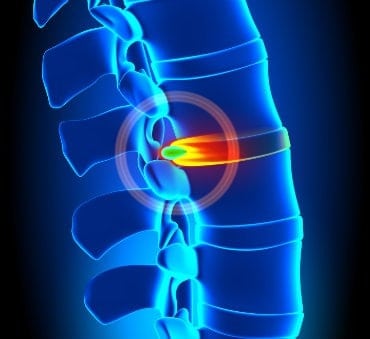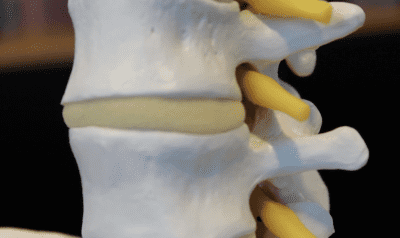What is a Herniated Disc?
A herniated disc refers to an issue with the disc material that sits between the individual bones making up the vertebrae in the spine. These discs act as shock absorbers and cushions for the bones.
The discs are similar to a jelly donut, with a soft center surrounded by a tough, protective exterior. When herniated, some of the “jelly” will protrude through a tear in the exterior, resulting in extreme chronic pain or discomfort.
Beyond the natural wear and tear of discs, there are certain factors that can contribute to one’s risk for developing a herniated spine. Some of these risk factors include:
- Gender. Men between 30 and 50-years-old are the most likely group to suffer from a herniated disc.
- Improper Lifting Technique. Using the back instead of the legs to lift a heavy object or twisting while lifting can both increase the risk for a herniated disc.
- Weight. Carrying excess body weight increases the stress on discs.
- Repetitive, Spine-straining Activities. Certain occupations, including those that involve a lot of pulling, bending or twisting, can place a substantial strain on the spine.
- Sedentary Lifestyle. Remaining in a sitting position for prolonged periods can increase the strain on the spine. Frequent driving is also an associated risk factor.
 Ravi R. Patel, M.D., an orthopaedic spine surgeon who specializes in minimally invasive surgery of the spine; cervical, thoracic and lumbar spine surgery; and adult spinal reconstructive surgery at Orlando Orthopaedic Center, says a herniated disc is one of the most frequent conditions he encounters in his practice.
Ravi R. Patel, M.D., an orthopaedic spine surgeon who specializes in minimally invasive surgery of the spine; cervical, thoracic and lumbar spine surgery; and adult spinal reconstructive surgery at Orlando Orthopaedic Center, says a herniated disc is one of the most frequent conditions he encounters in his practice.
“This pain can be extremely severe, even causing patients to come to the emergency room to seek relief,” Dr. Patel explains.
Typically, a patient with a herniated disc experienced pain in the following places:
- The back
- The buttock
- Radiating down into the thigh, calf and foot
For the majority of patients, a herniated disc will improve on it’s own, albeit slowly. One to two days of bed rest is normally helpful for alleviating severe back pain. For those with persisting pain, first-line treatments options are conservative and can include:
- Oral steroids to decrease inflammation and provide pain relief
- Oral medications for severe pain
- A combination of physical therapy and exercise to alleviate pressure on the nerve root
- Epidural injections to reduce pain and inflammation
- Manual traction to assist in opening up the cervical foramen where the nerve root exits the spinal canal
Minimally Invasive Surgery to Treat a Herniated Disc

Before considering surgery, an orthopaedic surgeon will most likely conduct imaging tests like X-rays or an MRI scan to get the best sense of the spine and disc structure and what surgery would be the most appropriate route. In the majority of cases, surgical treatments for herniated discs requires removing the protruding portion of the disc. Some of the common surgical procedures include:
- Anterior cervical discectomy and fusion (ACDF) – This procedure involves removing a disc from the cervical spine (neck) and placing a bone graft and/or implants in the area where the disc was to create stability.
- Cervical Disc Replacement – This procedure removes a patient’s cervical (neck) herniated disc and replaces it with an artificial disc eliminating the need for a fusion procedure.
- Cervical Laminoforaminotomy – This procedure, also called a posterior discectomy, is used to remove arthritic bone spurs and herniated discs from a posterior approach (back of the spine).
- Microdiscectomy – This procedure removes a lumbar (low back) herniated disc. This can be done with a relatively small open incision or even through tubes inserted into the operative area.
What to Expect After a Minimally Invasive Herniated Disc Surgery

- Location of the herniated disc
- Severity of the disc degeneration
- Severity of nerve compression
- How long the symptoms persisted prior to treatment
Regardless of the above factors, orthopaedic surgeons encourage most patients to try and remember the following while they recover:
- Sitting may not be comfortable at first. Patients generally begin to feel discomfort if they sit for longer than 15 or 20 minutes at a time.
- Walking is helpful for many reasons and should be incorporated into your recovery.
- Many patients are able to return to work and daily activities not long after the surgery, but doctors may encourage them to adhere to a rehabilitation program that involves physical therapy or home exercises.
- Patients who work in an office setting can typically expect to return to work within 2 and 4 weeks of their procedure. Meanwhile, patients with more physically-demanding jobs may be able to return to work 4 to 8 weeks after surgery.


